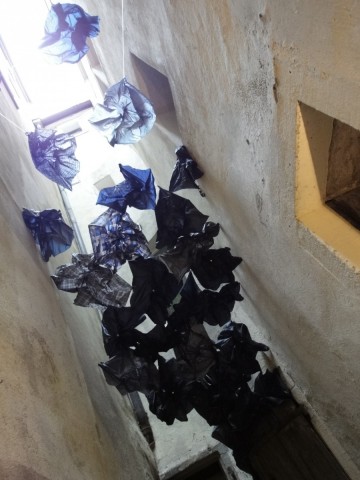Gian Michelle Grob
MOSTRA
October 30, 2010 – December 24, 2010
Three Euros – the price of a bird. When it rains in Rome the Romans buy an umbrella for three Euros. When the rain stops the cheap purchase is disposed of, that is to say, nonchalantly thrown into the nearest nook or cranny, where it is destined to remain. No wonder then, that after every heavy rainfall these black, bird-like objects can be found scattered around the streets of Rome. Gian Michelle Grob observed this rather amusing phenomenon on a number of occasions during her last studio scholarship and, although resolving to leave the ditched umbrellas where they were, she couldn’t help but pick up several examples.
Back in her studio, Grob stacked the umbrellas into a pile to form a flock of birds; these umbrellas are now taking to the wing in exactly the same manner in the Ehegraben. They rise up in the open courtyard to give the impression of birds flying freely skywards. Grob has rescued and used 70 umbrellas for this installation.
The fact that Grob developed this work during her studio scholarship in Rome can be seen as either pure coincidence or as a reference to the Arte Povera tradition. It was in 60s Italy that this movement first took hold and produced several renowned artists. In contrast to the American Pop Art movement, which blossomed in a prosperous economic climate, the Italian Arte Povera artists concentrated on crude or simple materials that emanated their own power and aura.
Grob’s installation skilfully explores the object trouvé and the Arte Povera spectrum within a new, sensual framework. She uses the umbrellas simply but effectively to create an immense physical presence in the confines of the Ehegraben and thus draws the viewer into the very heart of the enquiry surrounding the experience and sense of art.
The passage leading to the Ehegraben contains a series of photographs shot by Grob using the camera on her mobile phone. She approached museum visitors and took anonymous snapshots. Her intention was not to produce photographically perfect images, but images within images, which is further emphasised in the way the pictures are presented. With these 'trompe l'oeil'- like photographic wallpapers, Grob skilfully plays with illusion and spatial constriction to open up a new dimension for the viewer.
Back in her studio, Grob stacked the umbrellas into a pile to form a flock of birds; these umbrellas are now taking to the wing in exactly the same manner in the Ehegraben. They rise up in the open courtyard to give the impression of birds flying freely skywards. Grob has rescued and used 70 umbrellas for this installation.
The fact that Grob developed this work during her studio scholarship in Rome can be seen as either pure coincidence or as a reference to the Arte Povera tradition. It was in 60s Italy that this movement first took hold and produced several renowned artists. In contrast to the American Pop Art movement, which blossomed in a prosperous economic climate, the Italian Arte Povera artists concentrated on crude or simple materials that emanated their own power and aura.
Grob’s installation skilfully explores the object trouvé and the Arte Povera spectrum within a new, sensual framework. She uses the umbrellas simply but effectively to create an immense physical presence in the confines of the Ehegraben and thus draws the viewer into the very heart of the enquiry surrounding the experience and sense of art.
The passage leading to the Ehegraben contains a series of photographs shot by Grob using the camera on her mobile phone. She approached museum visitors and took anonymous snapshots. Her intention was not to produce photographically perfect images, but images within images, which is further emphasised in the way the pictures are presented. With these 'trompe l'oeil'- like photographic wallpapers, Grob skilfully plays with illusion and spatial constriction to open up a new dimension for the viewer.

